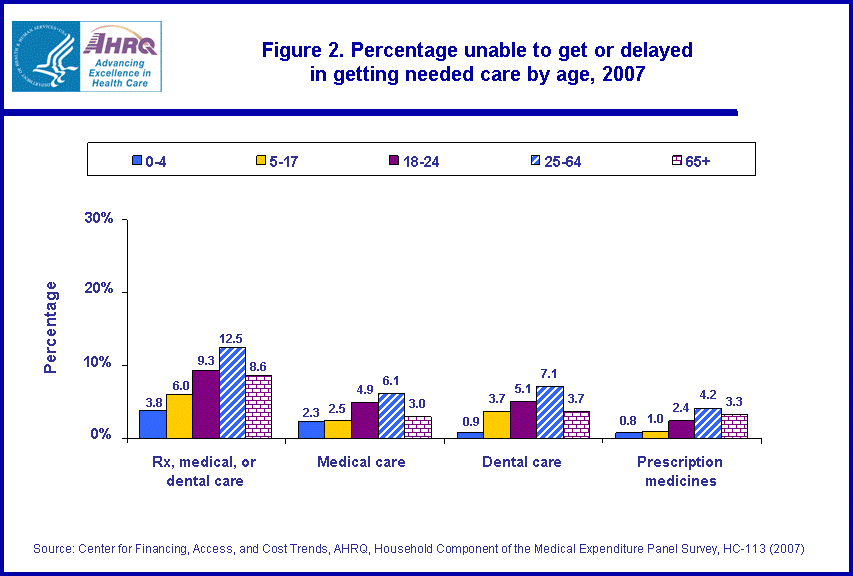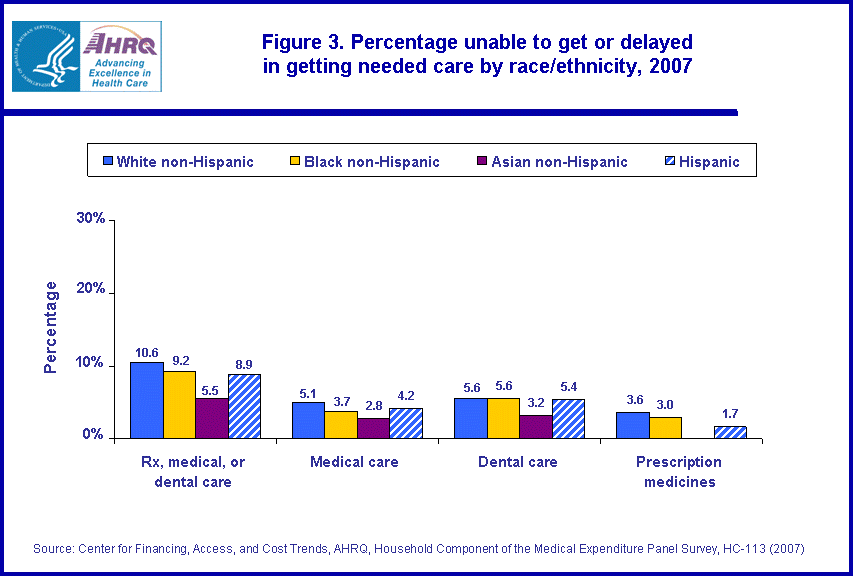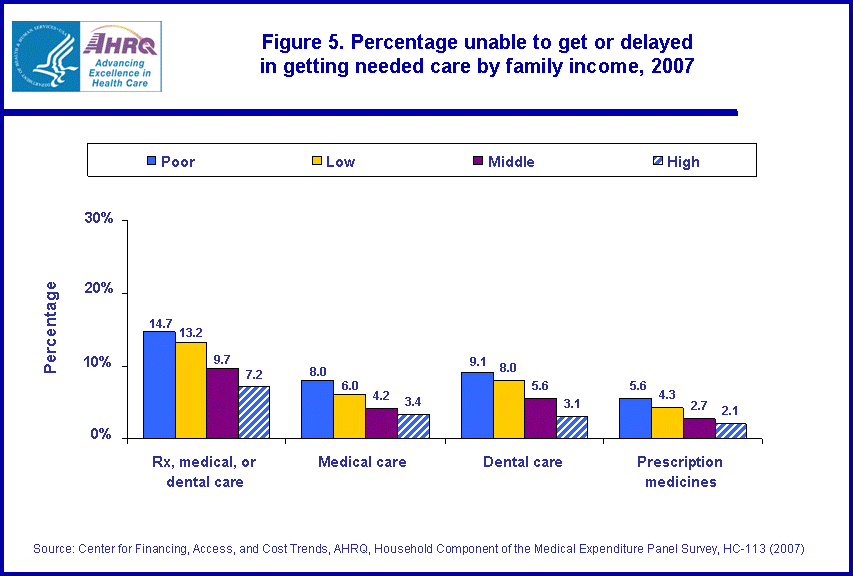
|
|
Font Size:
|
||||
|
|
|
|
||||
STATISTICAL BRIEF #282:
Percentage of Persons Unable to Get or Delayed in Getting Needed Medical Care, Dental Care, or Prescription Medicines: United States, 2007
Highlights
- In 2007, approximately 1 in 10 persons in the U.S. civilian noninstitutionalized population (approximately 30 million persons) reported to be unable to get or delayed in getting needed medical care, dental care, or prescription medicines in the last 12 months.
- In comparison to persons ages 18-24, persons ages 25-64 were more likely, and persons ages 0-4 and ages 5-17 were less likely to be unable to get or delayed in getting needed medical care, dental care, or prescription medicines.
- Non-Hispanic Asians (5.5 percent) were about half as likely as non-Hispanic whites (10.6 percent) to be unable to get or delayed in getting needed medical care, dental care, or prescription medicines.
- Adults ages 18 and over with at least a 4-year college degree (9.8 percent) were less likely than those with less than a high school degree (13.7 percent), those with a high school degree (11.8 percent), and those with a high school degree and some college (11.4 percent) to be unable to get or delayed in getting needed medical care, dental care, or prescription medicines.
- Persons in families who are poor (14.7 percent) are about twice as likely as persons in high income families (7.2 percent) to be unable to get or delayed in getting needed medical care, dental care, or prescription medicines in the last 12 months.
- For persons under age 65, uninsured persons (17.5 percent) are about twice as likely as persons with any private insurance (8.1 percent) to be unable to get or delayed in getting needed medical care, dental care, or prescription medicines.
Introduction
Access to health care is an important issue of public policy concern. Persons' perceptions of their unmet medical need is one set of indicators regarding access to health care. This Statistical Brief presents estimates of the percentage of persons unable to get or delayed in getting needed medical care, dental care, or prescription medicines in the last 12 months as reported in 2007. Data are provided by age, race/ethnicity, education, family income, and health insurance status. The estimates are derived from the household component of the Medical Expenditure Panel Survey (MEPS-HC). Unless otherwise indicated, all differences discussed in the text are statistically significant at the .05 level or better.
Findings
In 2007, approximately 1 in 10 persons in the U.S. civilian noninstitutionalized population (approximately 30 million persons) were unable to get or delayed in getting needed medical care, dental care, or prescription medicines in the last 12 months (figure 1). In 2007, an estimated 5.5 percent of the population were unable to get or delayed in getting needed dental care which was higher than the 4.7 percent of persons who were unable to get or delayed in getting needed medical care and the 3.1 percent of persons who were unable to get or delayed in getting needed prescription medicines.
Age. Persons ages 18-24 were more likely to be unable to get or delayed in getting needed medical care, dental care, or prescription medicines in the last 12 months than persons ages 0-4 and ages 5-17 (9.3 percent compared with 3.8 percent and 6.0 percent respectively) though less likely than persons ages 25-64 (9.3 percent versus 12.5 percent) (figure 2). This pattern of persons ages 18-24 having higher percentages than those ages 0-4 and 5-17, and lower percentages than those ages 25-64 held for the subgroup of being unable to get or delayed in getting needed prescriptions medicines. A comparable pattern held for the subgroup of being unable to get or delayed in getting needed dental care with the following exception: persons ages 5-17 were not significantly different from persons ages 18-24 (3.7 percent for persons ages 5-17 versus 5.1 percent for persons ages 18-24). For the subgroup of being unable to get or delayed in getting needed medical care, persons ages 18-24 (4.9 percent) were significantly more likely than those younger than age 18 (2.3 percent for ages 0-4, and 2.5 percent for ages 5-17) or older than age 64 (3.0 percent for ages 65 and over).
Race/ethnicity. Non-Hispanic whites (10.6 percent) were more likely to be unable to get or delayed in getting needed medical care, dental care, or prescription medicines in the last 12 months than non-Hispanic blacks (9.2 percent), non-Hispanic Asians (5.5 percent), or Hispanics (8.9 percent) (figure 3). Non-Hispanic Asians (5.5 percent) were about half as likely as non-Hispanic whites (10.6 percent) to be unable to get or delayed in getting needed medical care, dental care, or prescription medicines. For the medical care subgroup, non-Hispanic whites (5.1 percent) were more likely than non-Hispanic blacks (3.7 percent) and non-Hispanic Asians (2.8 percent) to be unable to get or delayed in getting needed medical care. For dental care, non-Hispanic whites (5.6 percent) were more likely than non-Hispanic Asians (3.2 percent) to be unable to get or delayed in getting needed dental care. For prescription medicines, non-Hispanic whites (3.6 percent) were more likely than Hispanics (1.7 percent) to be unable to get or delayed in getting needed prescription medicines.
Education. Adults ages 18 and over with at least a 4-year college degree were less likely than those with less education to be unable to get or delayed in getting needed care in the last 12 months (figure 4). An estimated 9.8 percent of adults with at least a 4-year college degree were unable to get or delayed in getting needed medical care, dental care, or prescription medicines compared with 13.7 percent for adults with less than a high school degree, 11.8 percent with a high school degree, and 11.4 percent with a high school degree and some college. This same pattern of adults with at least a 4-year college degree being less likely than those with less education to be unable to get or delayed in getting needed care holds for the dental care and for the prescription medicines subgroups. Persons with at least a 4-year college degree (9.5 percent) were less likely than those with less than a high school degree (12.4 percent) or with a high school degree (12.5 percent) or with a high school degree and some college (11.7 percent) to be unable to get or delayed in getting needed dental care. Similarly, persons with at least a 4-year college degree (2.9 percent) were less likely than those with less than a high school degree (4.0 percent) or with a high school degree (4.3 percent) or with a high school degree and some college (4.2 percent) to be unable to get or delayed in getting needed prescription medicines.
Family income. Persons with high family income were less likely (7.2 percent) than those who are poor (14.7 percent) or with low (13.2 percent) or middle (9.7 percent) family income to be unable to get or delayed in getting needed medical care, dental care, or prescription medicines in the last 12 months (figure 5). The largest difference was with persons in families who are poor (14.7 percent) who are about twice as likely as persons with high family income (7.2 percent) to be unable to get or delayed in getting needed medical care, dental care, or prescription medicines in the last 12 months. This same pattern of persons with high family income being less likely than those with less family income to be unable to get or delayed in getting needed care holds for the dental care and for the prescription medicines subgroups. Persons with high family income (3.1 percent) were less likely than those who are poor (9.1 percent) or with low (8.0 percent) or middle (5.6 percent) family income to be unable to get or delayed in getting needed dental care. Similarly, persons with high family income (2.1 percent) were less likely than those who are poor (5.6 percent) or with low (4.3 percent) or middle (2.7 percent) family income to be unable to get or delayed in getting needed prescription medicines. For medical care, persons with high family income (3.4 percent) were less likely than those who are poor (8.0 percent) or with low income (6.0 percent) and not significantly different from those with middle income (4.2 percent) to be unable to get or delayed in getting needed medical care.
Health insurance. Persons under age 65 and with any private insurance (8.1 percent) were less likely than those with public only insurance (12.0 percent) or uninsured persons (17.5 percent) to be unable to get or delayed in getting needed medical care, dental care, or prescription medicines (figure 6). The largest difference was with uninsured persons (17.5 percent) who are about twice as likely as persons with any private insurance (8.1 percent) to be unable to get or delayed in getting needed medical care, dental care, or prescription medicines. Persons with any private insurance were also less likely than those with public only insurance or uninsured persons to be unable to get or delayed in getting needed care for each of the three subcategories: medical care, dental care, and prescription medicines.
Data Source
The estimates in this Statistical Brief are based on data from the 2007 Full-Year Consolidated File (HC-113).
Definitions
Estimates for being unable to get or delayed in getting needed medical care, dental care, or prescription medicines are based on questions in the Access to Care section administered in rounds 2 and 4 of the MEPS household questionnaire.
Age
For this report, age refers to age at the time of the rounds 2 and 4 interviews (rounds in which the questions about being unable to get or delayed in getting needed care were asked).
Race/ethnicity
Classification by race/ethnicity in this report is based on the following four race/ethnicity groups: white single race non-Hispanic; black single race non-Hispanic; Asian single race non-Hispanic; and Hispanic. Classification by race and ethnicity is based on information reported in MEPS for each family member. First, respondents were asked if the person's main national origin or ancestry was Puerto Rican; Cuban; Mexican, Mexican American, or Chicano; Other Latin American; or other Spanish. All persons whose main national origin or ancestry was reported as one of these Hispanic groups, regardless of racial background, were classified as Hispanic. All other persons were classified according to their reported race. The residual category includes non-Hispanics of other races or multiple races and is not shown.
Education when first entered survey
Classifications by education when first entered the survey are based on the following four groups: Less than a high school degree; high school degree; high school degree and some college; and at least a 4-year college degree. Education when first entered survey is based on the first round in which the number of years of education and highest educational degree is collected for a person.
Family income status
Personal income from all family members within a household was summed to create family income. Based on the ratio of family income to the Federal poverty thresholds, which vary with family size and age of the head of the family, categories are defined as follows:
- Poor: Persons in families with income less than 100 percent of the poverty line, including those who reported negative income.
- Low income: Persons in families with income from 100-199 percent of the poverty line.
- Middle income: Persons in families with income from 200-399 percent of the poverty line.
- High income: Persons in families with income of at least 400 percent of the poverty line.
Individuals under age 65 were classified in the following three insurance categories, based on household responses to health insurance status questions:
- Any private health insurance: Individuals who, at any time during the year, had insurance that provides coverage for hospital and physician care (other than Medicare, Medicaid, or other public hospital/physician coverage) were classified as having any private health insurance. Coverage by TRICARE (Armed Forces-related coverage) was also included as private health insurance. Insurance that provides coverage for a single service only, such as dental or vision coverage, was not included.
- Public coverage only: Individuals were considered to have public coverage only if they met both of the following criteria: 1) they were not covered by private insurance at any time during the year, and 2) they were covered by any of the following public programs at any point during the year: Medicare, Medicaid, or other public hospital/physician coverage.
- Uninsured: The uninsured were defined as people not covered by any private hospital/physician insurance, Medicare, TRICARE, Medicaid, or other public hospital/physician programs at any time during the entire year or period of eligibility for the survey.
About MEPS-HC
The MEPS Household Component (HC) is a nationally representative longitudinal survey that collects detailed information on health care utilization and expenditures, health insurance, and health status, as well as a wide variety of social, demographic, and economic characteristics for the U.S. civilian noninstitutionalized population. It is cosponsored by the Agency for Healthcare Research and Quality and the National Center for Health Statistics.
For more information about MEPS, call the MEPS information coordinator at AHRQ (301) 427-1656 or visit the MEPS Web site at http://www.meps.ahrq.gov/.
References
For a detailed description of the MEPS-HC survey design, sample design, and methods used to minimize sources of nonsampling error, see the following publications:
Cohen, J. Design and Methods of the Medical Expenditure Panel Survey Household Component. MEPS Methodology Report No. 1. AHCPR Pub. No. 97-0026. Rockville, MD: Agency for Health Care Policy and Research, 1997. http://www.meps.ahrq.gov/mepsweb/data_files/publications/mr1/mr1.shtml
Cohen, S. Sample Design of the 1996 Medical Expenditure Panel Survey Household Component. MEPS Methodology Report No. 2. AHCPR Pub. No. 97-0027. Rockville, MD: Agency for Health Care Policy and Research, 1997. http://www.meps.ahrq.gov/mepsweb/data_files/publications/mr2/mr2.shtml
Cohen, SB. Sample Design of the 1997 Medical Expenditure Panel Survey Household Component. Rockville (MD): Agency for Healthcare Research and Quality, 2000. MEPS Methodology Report No. 11, AHRQ Pub. No. 01-0001. http://www.meps.ahrq.gov/mepsweb/data_files/publications/mr11/mr11.shtml
Cohen, S. Design Strategies and Innovations in the Medical Expenditure Panel Survey. Medical Care, July 2003: 41(7) Supplement: III-5-III-12.
Ezzati-Rice, TM, Rohde, F, Greenblatt, J. Sample Design of the Medical Expenditure Panel Survey Household Component, 1998-2007. Methodology Report No. 22. March 2008. Agency for Healthcare Research and Quality, Rockville, MD. http://www.meps.ahrq.gov/mepsweb/data_files/publications/mr22/mr22.shtml
Suggested Citation
Chevarley, FM. Percentage of Persons Unable to Get or Delayed in Getting Needed Medical Care, Dental Care, or Prescription Medicines: United States, 2007. Statistical Brief #282. April 2010. Agency for Healthcare Research and Quality, Rockville, MD. http://www.meps.ahrq.gov/mepsweb/data_files/publications/st282/stat282.shtml
AHRQ welcomes questions and comments from readers of this publication who are interested in obtaining more information about access, cost, use, financing, and quality of health care in the United States. We also invite you to tell us how you are using this Statistical Brief and other MEPS data and tools and to share suggestions on how MEPS products might be enhanced to further meet your needs. Please e-mail us at MEPSPD@ahrq.gov or send a letter to the address below:
Steven B. Cohen, PhD, Director
Center for Financing, Access, and Cost Trends
Agency for Healthcare Research and Quality
540 Gaither Road
Rockville, MD 20850
 |
||||||||||||||||||||||||||||||||||||||||
|
||||||||||||||||||||||||||||||||||||||||
|
|
||||||||||||||||||||||||||||||||||||||||
 |
||||||||||||||||||||||||||||||||||||||||
|
||||||||||||||||||||||||||||||||||||||||
|
|
||||||||||||||||||||||||||||||||||||||||
 |
||||||||||||||||||||||||||||||||||||||||
|
||||||||||||||||||||||||||||||||||||||||
|
|
||||||||||||||||||||||||||||||||||||||||
 |
||||||||||||||||||||||||||||||||||||||||
|
||||||||||||||||||||||||||||||||||||||||
|
|
||||||||||||||||||||||||||||||||||||||||
 |
||||||||||||||||||||||||||||||||||||||||
|
||||||||||||||||||||||||||||||||||||||||
|
|
||||||||||||||||||||||||||||||||||||||||
 |
||||||||||||||||||||||||||||||||||||||||
|
||||||||||||||||||||||||||||||||||||||||
|
|
||||||||||||||||||||||||||||||||||||||||


